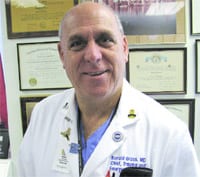Have a Plan for Visiting the ER
Patients know it can be crowded, sometimes resulting in long waits. Physicians might say it operates with “organized chaos.”
However it’s characterized, the ER has become the place to go for emergency medical care, as the numbers attest: an estimated one of every five Americans visits a hospital emergency department each year, for a total of nearly 130 million visits annually. It has become the nation’s medical safety net, where everyone, regardless of age, status, ability to pay, or any other criteria, can be treated for medical emergencies, 24 hours a day, every day of the year.
Emergency medicine has come a long way since it was first given separate status as a medical specialty in 1972. Physicians who work in ERs specialize in emergency medicine and are trained in multiple areas — such as adult medicine, pediatrics, obstetrics, and surgery. They can treat all patients coming through the door, whether they have a minor illness, major trauma, or life-threatening condition.
While the moniker ‘ER’ has stuck over the years, it’s really a misnomer. Today’s emergency room is a sophisticated department within the hospital, able to provide multiple medical functions, with resources to handle just about any condition.
Emergency medical personnel are capable of identifying a patient’s illness, triaging him or her through the department, and completing all the necessary, complex tests that may be needed, such as blood analyses, X-rays, and other diagnostics. They can also quickly call on other specialists, such as cardiologists, neurologists, or surgeons, should they be needed.
The process of triage — determining medical priority — is often a first step in an emergency department visit and helps the staff identify patients who need the most immediate attention. The cardinal rule for emergency departments is simple: those with the most urgent conditions get attention first. The determination may not always be obvious. Someone with severe chest pain that could signal a heart attack, for example, or someone with speech difficulty that might indicate a stroke, will get attention before others who have lesser, but perhaps more visible, injuries or symptoms. Many emergency departments also have a fast-track area where urgent but less-life-threatening problems can be seen quickly.
So when should you go to the emergency department? If possible, check first with your primary-care physician and seek his or her opinion. But don’t delay with certain symptoms, such as severe chest pain, difficulty breathing, heavy bleeding, or signs of a stroke. It’s difficult for patients to triage themselves, so if you feel you have a true emergency, go straight to the emergency department.
Patients today also have other options to consider for immediate medical attention, such as urgent-care centers and retail clinics. These facilities may be fine for some conditions, but they are generally not as well-equipped with staff and resources, nor open around the clock as hospital emergency departments are, so where to go for a specific type of illness or injury will require some thought.
Because nobody knows when an emergency might happen, we urge everyone to prepare for the possibility of one. Have a plan and discuss it with your primary-care physician, who might suggest a specific hospital because he or she has staff and admitting privileges there. Decide which ER to go to, and know its exact location and how to get there. Choose transportation based on the nature of the emergency; for example, don’t drive yourself if you’re having chest pains or signs of a stroke.
We also recommended keeping and carrying with you up-to-date lists of medications, medical conditions (such as diabetes or high blood pressure), allergies, and names and contact information of primary-care physicians and relatives. Unfortunately, few patients do this, but having such information readily available is a great help to emergency medical personnel. Advance directives, indicating preferences for care if you’re unable to communicate, should also be accessible.
A visit to the ER can be a stressful and even frightening experience, so the better prepared you are, the more quickly and efficiently medical staff can take care of you.
To learn more about emergency medical care, visit the American College of Emergency Physicians at www.emergencycareforyou.org
Dr. Nathan Macdonald, is chief of Emergency Medicine at Lowell General Hospital and president of the Mass. College of Emergency Physicians (MACEP). Dr. Jeffery Hopkins is chief of Emergency Medicine at Milford Regional Medical Center and treasurer of MACEP. This article is a service of the Mass. Medical Society.



Comments are closed.